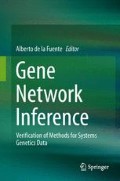Abstract
Ordinary Differential Equations (ODEs) represent a deterministic approach to model gene regulatory networks. ODEs can be used to model changes in gene transcription induced by an external perturbation, such as gene overexpression/downregulation or treatment with a drug. Reverse-engineering algorithms based on ODEs require a choice of a functional form describing the effect of a regulator on its target genes. Here, we focused on an ODE-based reverse engineering algorithm named Network Identification by multiple Regression (NIR) which is rooted on the hypothesis that the regulation exerted by one gene (i.e., a TF) on a target gene can be approximated by a linear function, i.e., the transcription rate of the target gene is proportional to the amount of TF. NIR uses steady-state gene expression measurements and requires knowledge of the genes perturbed in each experiment. We showed that even if originally NIR was created for a different purpose, it can be successfully used to infer gene regulation from an integrated genotype and phenotype dataset. Our results provide evidence of the feasibility of applying reverse-engineering algorithms, such as NIR, to infer gene regulatory networks by integrated analysis of genotype and phenotype.
Access this chapter
Tax calculation will be finalised at checkout
Purchases are for personal use only
Notes
- 1.
A perturbation \(u_{l}\) is defined small if the system returns to the original steady-state point after removal of \(u_{l}\) and if the magnitude of the response is roughly proportional to the magnitude of \(u_{l}\) (typically the \(10\,\%\) of the original mRNA concentration).
References
Adam M, Ilya N, Katia B, Chris W, Riccardo F, Andrea C (2006) ARACNE: an algorithm for the reconstruction of gene regulatory networks in a mammalian cellular context. BMC Bioinform 7: S7+
Andreopoulos B, An A, Wang X, Schroeder M (2009) A roadmap of clustering algorithms: finding a match for a biomedical application. Briefings bioinform 10:297–314
Bansal M, Belcastro V, Ambesi-Impiombato A, di Bernardo D (2007) How to infer gene networks from expression profiles. Mol Syst Biol 3:78
Basso K, Margolin AA, Stolovitzky G, Klein U, Dalla-Favera R, Califano A (2005) Reverse engineering of regulatory networks in human B cells. Nat Genet 37:382–390
Cantone I, Marucci L, Iorio F, Ricci MA, Belcastro V, Bansal M, Santini S, di Bernardo M, di Bernardo D, Cosma MP (2009) A yeast synthetic network for in vivo assessment of reverse-engineering and modeling approaches. Cell 137:172–181
Chen PC (2004) A computational model of a class of gene networks with positive and negative controls. Biosystems 73:13–24
Clarke R, Ressom HW, Wang A, Xuan J, Liu MC, Gehan EA, Wang Y (2008) The properties of high-dimensional data spaces: implications for exploring gene and protein expression data. Nat Rev Cancer 8:37–49
de Jong H (2002) Modeling and simulation of genetic regulatory systems: a literature review. J Computl Biol 9:67–103
de la Fuente A, Bing N, Hoeschele I, Mendes P (2004) Discovery of meaningful associations in genomic data using partial correlation coefficients. Bioinformatics 20:3565–3574
Draper NR, Smith H (1998) Applied regression analysis. In: Draper NR, Smith H (eds) Wiley Series in Probability and Statistics, 3rd edn. Wiley, New York
Faith JJ, Hayete B, Thaden JT, Mogno I, Wierzbowski J, Cottarel G, Kasif S, Collins JJ, Gardner TS (2007) Large-scale mapping and validation of escherichia coli transcriptional regulation from a compendium of expression profiles. PLoS Biol 5:e8+
Gardner TS, di Bernardo D, Lorenz D, Collins JJ (2003) Inferring genetic networks and identifying compound mode of action via expression profiling. Sci New York NY 301:102–105
Gregoretti F, Belcastro V, di Bernardo D, Oliva G (2010) A parallel implementation of the network identification by multiple regression (NIR) algorithm to reverse-engineer regulatory gene networks. PLoS ONE 5:e10179
Kauffman SA (1969) Homeostasis and differentiation in random genetic control networks. Nature 224:177–178
Kauffman SA (1993) The origins of order: self-organization and selection in evolution, 1st edn. Oxford University Press, USA
Marbach D, Costello JC, Küffner R, Vega NM, Prill RJ, Camacho DM, Allison KR, The DREAM5 Consortium, Kellis M, Collins JJ, Stolovitzky G (2012) Wisdom of crowds for robust gene network inference. Nat methods 9:796–804
Newman MEJ (2003) The structure and function of complex networks. SIAM REVIEW 45:167–256
Sima C, Hua J, Jung S (2009) Inference of gene regulatory networks using time-series data: a survey. Curr Genomics 10:416–429
Someren EPV, Wessels L, Reinders M, Backer E (2001) Searching for limited connectivity in genetic network models. In: Proceedings of the second international conference on systems biology.
Somogyi R, Sniegoski C (1996) Modeling the complexity of genetic networks: understanding multigenic and pleiotropic regulation. Complexity 1:45–63
Szallasi Z, Liang S (1998) Modeling the normal and neoplastic cell cycle with realistic Boolean genetic networks: Their application for understanding carcinogenesis and assessing therapeutic strategies. Pac Symp Biocomputing 3:66–76
Author information
Authors and Affiliations
Corresponding authors
Editor information
Editors and Affiliations
Rights and permissions
Copyright information
© 2013 Springer-Verlag Berlin Heidelberg
About this chapter
Cite this chapter
Gambardella, G., Pagliarini, R., Gregoretti, F., Oliva, G., di Bernardo, D. (2013). Differential Equation Based Reverse-Engineering Algorithms: Pros and Cons. In: de la Fuente, A. (eds) Gene Network Inference. Springer, Berlin, Heidelberg. https://doi.org/10.1007/978-3-642-45161-4_4
Download citation
DOI: https://doi.org/10.1007/978-3-642-45161-4_4
Published:
Publisher Name: Springer, Berlin, Heidelberg
Print ISBN: 978-3-642-45160-7
Online ISBN: 978-3-642-45161-4
eBook Packages: Biomedical and Life SciencesBiomedical and Life Sciences (R0)

